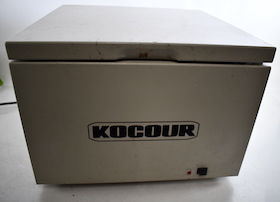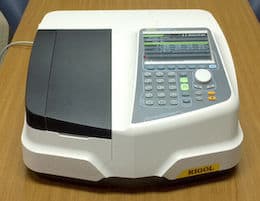
Curated with aloha by
Ted Mooney, P.E. RET

The authoritative public forum
for Metal Finishing 1989-2025

-----
Lab setup for plating shop Q&A
Q. My company runs a captive nickel plating shop. We have had our solutions analyzed outside, but we are now going to set up an in-house lab. We have the technical skills and the sources for lab equipment, but I'd like to have suggestions about the physical arrangement of a plating shop lab. I'd like to also know of any problems that any of you may have run into in your own labs.
Rick Alexanderengravers - Gaffney, South Carolina
1999
by Terrance H Irvine
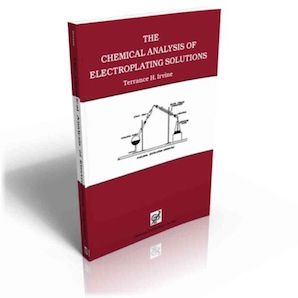
on eBay or
AbeBooks
or Amazon
(affil links)
by Langford & Parker
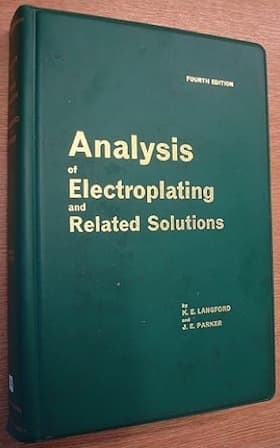
on Abebooks
or Amazon
(UTL on eBay)
(affil links)
A. Your lab setup will depend a lot on what you plan to do. For titrations you should have an area to prep and titrate the samples. If you plan on doing Hull Cells
⇦ this on
eBay
or
Amazon [affil links] , have an area to set up for that. A fume hood for heating samples and mixing acids is a good idea.
One important note is to check your states OSHA requirements concerning lab safety requirements. I know in Maryland MOSHA looks closely at lab setups. Also, having your lab sink plumbed to a holding tank or to your WTS [waste treatment system] is a good idea. These are just a few suggestions. It might be wise to think of it as you would a new process ... have a detailed written plan of exactly what you want and need before beginning.
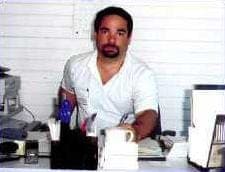
Jim Conner
Anoplex Software
Mabank, Texas USA

A. All of Jim's suggestions are excellent. You might also want to start thinking about an accurate and detailed system for record keeping and documentation. There are some good lab software programs for plating shops on the market.
Also if you are going to be having some strict quality audits it might be a good idea to have your glassware and chemistry come with certificates of accuracy traceable to NIST. A good pH meter ⇦ this on
eBay or
Amazon [affil links]
and analytical balance
⇦ this on
eBay or
Amazon [affil links] will probably also come in handy. Also what type of nickel are you plating? Is there a need to monitor stress? If so you might also want to consider a spiral contractometer.
Dayton, Ohio
A. You mentioned that you have the technical skills to back your lab. Be sure that includes a chemist that is experienced with commercial plating processes. I've visited lots of places where the resident senior plater, resident engineer or even technician has been the "lab guru". The results have been lots of black magic. No offense, but you can't replace the skills offered from a degreed chemist.
Greg FuquaJacksonville, Florida
A. Rick, contact me. I am the poor man's plater (chemist/metallurgist) and have set up a couple of labs. I will ask lots of questions before giving opinions.
Fortunately, nickel is a fairly easy lab to operate for a technically inclined person, once they have been shown the endpoints.
All of the previous opinions are valid.
James Watts- Navarre, Florida
[contact info deleted due to age of posting; if James offers again, we'll make his contact info available again]
Multiple threads merged: please forgive chronology errors and repetition 🙂
Cost and requirements to set up an internal lab
Q. My company currently performs a multitude of platings and has always utilized outside labs. Recently we have had some difficulty associated with hard chrome and nickel. Utilizing outside labs has caused some delays on results/recommended adjustments. Our shop personnel have requested me to research the feasibility on bringing lab services inside (which we are not currently equipped for).
Can someone offer what kind of cost is associated with bringing in a lab and personnel necessary to run it? I personally do not believe this is a good option for us as we are small and currently do not possess the skill level required to do this. Historically over many years, we have had great success with our lab results and recommended adjustments.
- Kent, Washington USA
June 10, 2015
|
A. That all depends on which tests you might want to do in house. - Navarre, Florida A. Roger - Colorado Springs, Colorado |
A. Roger,
I agree with the responses to the older question that yours was appended to. The cost and other factors associated with setting up your lab depends on what processes you need to do there. It's fairly easy to pick up the basics new or used (beakers [beakers on
eBay
or
Amazon [affil links] , graduated cylinders ⇦ this on
eBay or
Amazon [affil links]
, hot plates
⇦ this on
eBay or
Amazon [affil links]
, balances). Things like titrations are rather simple to do once you know how and only requires a few bits of specialized gear and not much space, but other types of analytical equipment can be rather pricey. As Jim Conner said, you may need to install a fume hood depending on legal requirements and how noxious the chemicals are that you will be working with.
As for having a qualified chemist on board, most of this type of thing is like cooking. If you can follow a recipe, you can bake a cake, but you probably don't know what all the different ingredients do or why those specific amounts are needed, and if something goes wrong that isn't mentioned in the cookbook, you won't know how to fix it. So it basically comes down to your comfort level on whether you want to bake the cake yourself, possibly with the number of a consulting chef on hand, or just outright hire a chef onto staff.

Ray Kremer
Stellar Solutions, Inc.
McHenry, Illinois

A. You can do everything with titrations except sulphate in the chrome bath. For that you need an analytical balance. So, buret, glassware, prepared titrants ... you can get away with a few hundred bucks.

Dave Wichern
Consultant - The Bronx, New York
A. Good day Roger.
All of the responses have given good info. You can make cookies, or you can make pastry, just follow the recipe and repeat, exactly, each and every time. Since you are doing nickel and chrome, your supplier can do the trivalent chrome, and you can do the sulphate with a centrifuge from Kocour.
Chromic acid is dead easy.
I would strongly recommend purchasing a hull cell
⇦ this on
eBay
or
Amazon [affil links] for the nickel, as it is a useful tool for brighteners, and determining consumption based on amp hours. Nickel metal, sulphates, chlorides and boric are all dead easy.
Why not address the cleaners and acids also, since you wish to do in-house analysis.
My boss, many years ago, had asked me to help out in the lab. I had plating and waste treatment experience, which really made the learning curve that much easier.
It is a learning curve for all involved. Be patient and persevere, the results are truly rewarding.
Good luck, and tell us how your kitchen is doing!
Regards,
Lab Tech. - Whitby, On, Canada
![]() Great post, Eric.
Great post, Eric.

Dave Wichern
Consultant - The Bronx, New York
Thanks Dave.
Regards,
Lab Tech. - Whitby, On, Canada
July 27, 2015
Multiple threads merged: please forgive chronology errors and repetition 🙂
New lab for my shop

Aluminum How-To
"Chromating - Anodizing - Hardcoating"
by Robert Probert
Also available in Spanish
You'll love this book. Finishing.com has sold almost a thousand copies without a single return request :-)
Q. I want to start a new lab to analyze my tanks and all the processes I do at my shop. Anodize, dyes (colors), electroless nickel, passivate, and chem film (gold Class 1A & 3), & (Type II, Class 1A & 3 RoHS). Need to buy new equipment and need to find a chemist who can help me. Or how can I learn to do the chemistry myself. Please help and thank you for your feedback.
David Limon- Oxnard, California USA
August 29, 2020
A. Hi David.
You don't really need a chemist, you just need a competent lab tech, as the tests are simple.
I don't know the electroless nickel test but for the others:
Soap- generally just measured as total alkalinity in an acid-base neutralization.
Anodize- Sulfuric content, aluminum content (2 side by side acid-base neutralization tests, one with and the other without a flocculant to drop and hold the Al, compare results).
Passivate- Nitric content (acid-base), dichromate content, which is measured by an oxidation potential titration (unless you're running citric, in which case it's citric content, which is acid-base).
Caustic etch- Hydroxide content (acid-base).
Deox/desmut- depending what you use, nitric content and/or oxidation potential.
Yellow chromate- this is another oxidation potential test, and also pH.
RoHS chromate- pH in house, then send samples to the manufacturer for testing, though if you buy a UV-vis spectrophotometer you can do it in house using quartz cells in the UV range, but I just send them out for my monthly complimentary manufacturer testing.
Nickel seal- manufacturer's titration which is a compleximetric test using EDTA.
Dyes- pH in house, manufacturer may offer x number of concentration tests per month, or use a spectrophotometer in the visible range, disposable plastic cells are fine for this.
I got an old ~1996 Shimadzu UV-1201 S benchtop unit with a new bulb on eBay for about $500 (which is about how much a replacement bulb costs lol). The 90s models are super deals if the bulb is in good shape and the LCD screen is not burned out, but good luck finding non-bulb parts if the machine fails.
Other equipment you'll need is a buret stand and burets (the burets should hold 50 mL each, except for the one you use for the seal bath; that one you can use a 10mL; you will need 4-5 of them, plastic is fine, a magnetic stir plate (unheated) and stir bar, 250 mL beakers [beakers on
eBay
or
Amazon [affil links] s, a pair of pipets (5 mL and 1 mL), a couple graduated cylinders (25 mL and 100 mL), and if you are testing dyes and RoHS chemfilm in house you need volumetric flasks to make your standards and then Excel to generate a calibration curve for how the spectrophotometer is interpreting things that day (seriously it's most accurate when you warm it up, calibrate, and set your curve at every use).
And of course you need a set of pH cal standards, assorted reagents, and indicators to run the tests. And you DEFINITELY need a case of LDPE squirty dispenser bottles that hold 500mL for your reagents (trust me you do NOT want to try to zero a buret out of a bottle) and for your dilution/rinse water.
The titration instructions can be obtained from the material manufacturer tech rep, if they're not right in the TDS. And I've posted a couple detailed instructions for some other standard titrations on here. The acid-base neutralization ones are dead simple. The only differences being the direction you're going, the reagent and indicator you use, and the calculation that applies to that particular tank.
Poke around and call your tech reps and if there are any holes in what you come up with, check back and I'll try to fill them in. At this point I could do them in my sleep haha
No time to type everything out from scratch but I can certainly cut 'n paste whatever you need... it may take a bit... happy to provide tech support :)

Rachel Mackintosh
lab rat - Greenfield, Vermont
![]() Thank you, Rachel. I will start looking for the items you have recommended.
Thank you, Rachel. I will start looking for the items you have recommended.
Q. A couple more questions if you don't mind. Is there a newer unit I can buy that does the same thing as the Shimadzu UV-1201 S benchtop? If so can you recommend any? Are there any more solutions or chemicals I need to buy to do the testing that I have posted? Because I'm going to place my order soon for all that you have recommended.
David Limon [returning]- Oxnard California
A. Hi David,
Hold off on the spectrophotometer until you're SURE you want to do those tests in house. Both the dye manufacturer and RoHS chromate manufacturer I buy from offer 1-2 tests per month so we just send them 60mL specimens (you will need small Nalgene or similar plastic jars. HDPE, LDPE, and PET are all fine to send as long as the caps don't leak). Yes there are newer ones, and nicer ones with a scan function and data output and all that jazz but you may not even need it unless you are custom-blending /shading dye colors (the only reason I have mine; for the love of all that is holy, never let a customer talk you into making them their very own special three-component dye color). And wait til ya see the price tag on a good machine lol.
Once you have your test list from the manufacturers, the materials you need will be right in there but I can GUARANTEE you should order, to start:
Sodium hydroxide, 1N ⇦ this on
Amazon [affil links]
(get your NaOH by the 4L bottle; you'll go through a TON of this stuff; other liquids a liter at a time is reasonable)
*sodium thiosulphate
⇦ this on
eBay
or
Amazon [affil links]
, 0.1N
Potassium Fluoride, 50%wv
*Potassium iodide, solid
Hydrochloric acid, 1N ⇦ this on
Amazon [affil links]
*Sulfuric acid, 50% or just dilute it accordingly from drum strength, this doesn't have to be accurate as it's just for preconditioning samples for a RedOx test
*Starch indicator with salicylic acid
bromocresol green
⇦ this on
eBay &
Amazon [affil links]
phenolphthalein
⇦ this on
eBay &
Amazon [affil links]
bromophenol blue
⇦ this on
eBay or
Amazon [affil links]
(even if the soap test calls for methyl red. The color change for MR is REALLY hard to parse even for a crusty old lab rat).
*If you're using Alodine rather than Iridite, I'm not sure if they'll give instructions using the permanganate method instead, in which case, I'm sorry; prepare for lots of stained everything. All the MacDermid instructions including for their DeOx that I like, are for the much more agreeable Thiosulphate reducing agent method, which is also the right one to use for Cr+6 in passivation baths and dichromate seal for ano.
I don't know what your nickel seal bath is, but the one that seems to be ridiculously common requires more reagents:
EDTA 0.1M / 0.2N
⇦ this on
eBay
or
Amazon [affil links]
Ammonium hydroxide
⇦ this on
eBay
or
Amazon [affil links] (35% but you can adjust volume if weaker; it's a conditioning agent not the titrant)
Ammonium purpurate/ murexide
[affil links] powder (Fisher Chemical part# M-274 and it ain't cheap). Luckily you need about the equivalent weight of a couple grains of salt per week and it does not expire. I've been using the same 5g bottle for 7 years and haven't even made a dent in the supply.
Also this is a test that you'll want to do either in a hood, or a well ventilated space, or you know... in the parking lot ... not that it's particularly toxic to breathe for a few minutes per week, but the ammonia fumes are eye wateringly strong.
Most of this stuff is readily available through one of the big industrial supply houses (Grainger; their house brand LabChem).

Rachel Mackintosh
lab rat - Greenfield, Vermont
Q. Is it okay to carry out titration for solution analysis on the workshop floor itself? Is fume hood necessary for carrying out titrations for solution analysis for plating and anodising solutions?
Nad Al- Singapore
December 31, 2020
A. Hi Nad. One of our most knowledgable contributors, Robert Probert, has noted that some titrations really must be performed tank-side for correct results. But some should probably only be performed under a fume hood. And others, where's it's a precision few drops of this and that, are probably well suited for an open area of the lab. I suspect that there isn't an answer to the general case, only to specific cases. Can you name one or two specific titrations you are thinking of?
Luck & Regards,

Ted Mooney, P.E. RET
Striving to live Aloha
finishing.com - Pine Beach, New Jersey
Q. Hi,
If I intend to have a small in house lab, may I know what is required for a lab sink set up for the intended use of washing titration equipment?
How do I collect the titration waste? Thank you for the help.
- Jakarta Indonesia
January 25, 2021
Q, A, or Comment on THIS thread -or- Start a NEW Thread

